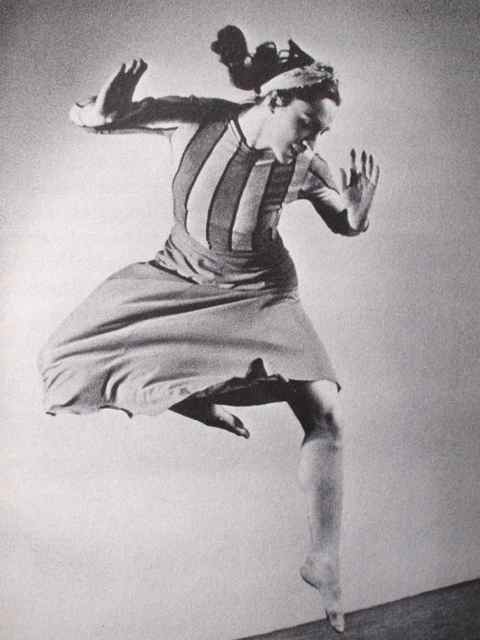
|
.
|
 
In the late 1920s and early 1930s, a workers' dance movement came up in New York. Looking for new forms of body expressions, the movement had strong relations to the workers' movement and the communist party. The New Dance Group interpreted "The Dance is a Weapon" (1933), a clear statement in the political and artistic avantgarde-line of "Kunst ist Waffe!" (by Friedrich Wolf, 1928). Part of a big workers' cultural movement, the dance groups' umbrella organization was The Workers Dance League (funded in 1932) with the slogan: Dance is a weapon in the revolutionary class struggle. The associations held Spartakiades (as we can see them in Kuhle Wampe, sportive and cultural competitions). The pageants or mass events brought revolutionary contents to the proletarian masses as agit prop and the workers could easily bring themselves in as active part of dance groups, theatre groups or singing groups. Dance appears as near to the industrialized working process as Meyerhold describes his Biomechanics. Important figures were: Martha Graham, Mary Wigman, Edith Segal, Anna Sokolow; Hanya Holm, Helen Tamiris The protagonists and the audience of modern dance choreographies and may day parades, party meetings and actions were the same. People soaked in modern dance as well as marxist theory: "Far from being antagonists, the two movements creatively coexisted, exchanging audiences, bodies, and ideas." (13) All of this was joined with the revolutionary vision of the soviet union. Most of them were poor jewish immigrants from eastern Europe whose families immigrated around 1900. The protagonist of modern dance was the newly immigrated working class. Workers danced out their issues: Idea of participation. Amateurs and professionals took part. New human beings, new bodies The female body was recast as an instrument of force and power, not longer shown as exotic decoration or mother. Edith Segal and the Red Dancers 1928: Workers's pageant at Madison Square Garden. 1000 actors/dancers, 20.000 spectators, 200 singers/chorus. Edith Segal shows a dance formation as hammer and sickle, transcending individual boundaries. Segal performs in a memorial service to Lenin's death in 1924, being the first political party dance performance ever. She organizes a children's dance group where she teaches dance and class consciousness. The group becomes later part of the young pioneers movement of the CP. With her amateur group, the Red Dancers, she acts very often in working class contexts, educating and entertaining and gaining new members. Segal works with the abstraction of movements, static poses and stylization. She looks for collective solutions, putting emphasis on the "we" of the group, merging borders between professionals and amateurs, director and dancers, stage and spectators. (44) Although working with formalization, Segal is criticized for being too predictable in her stories which are very often agitation pieces. For her, in dance, there is a "complicity of the body" with the communist cause. Black and White Segal begins to collaborate with the black choreographer and dancer Burroughs. The fight against racial discrimination becomes an issue of the CP. After the first performance of both in 1930, Duke Ellington and his band play and black and white workers dance the latest styles together. Segal directed many working class dance groups in the early 1930's, as Nature Friends Dance Group, Needle Trades Workers Industrial Union Dance Group, and children's dance groups at the jewish Shules (religious schools). ]In a typical workers' dance group, membership came usually through the union, but was not necessary. Like that, unions recruited new members through political discussions before and after rehearsal. The content of the dance scenes came from the workers' daily lifes and labour struggles. Union and workers' dance league provided ideological or professional aid; the unions provided the rehearsal space. "One purpose of such groups was to get workers moving politically and to prime them for actual strike actions and picketing. Workers' classes made up scenarios that they danced as a kind of rehearsal for the real thing." (42) Activist and artist Jane Dudley writes in New Theatre: "Large groups of lay dancers can by careful direction set simple but clear patterns of group movement into a form that presents our revolutionary ideas (…). " The dancers learn to move communally in the training and to think ideologically in the rehearsal discussions. Dudley's revolutionary dance class began with simple movements evoking a sense of community in the group. Movements structures as walking, creeping etc. were related to develop concrete situations, as strike or repression. The groups (workers, pickets, militia) had assigned movements themes. The dance's climax is reached when workers and picketers unite and together press the militia back. Choreographies/Performances: Segal, Black and White After 1935, Roosevelt's new deal and Stalin's socialist realism disminished the idealization of the soviet union. The ideological construct of the "people" became nationalized. The Workers Dance League changed its Name to New Dance League, hiding its class character. Amateur performances by workers' associations ceased. Segal works mainly as a teacher/choreographer for children and teenagers at the jewish-communist Camp Kinderland. (Quotes and pictures from: Ellen Graff, Stepping Left. Dance and Politics in New York City, 1928-1942)        |